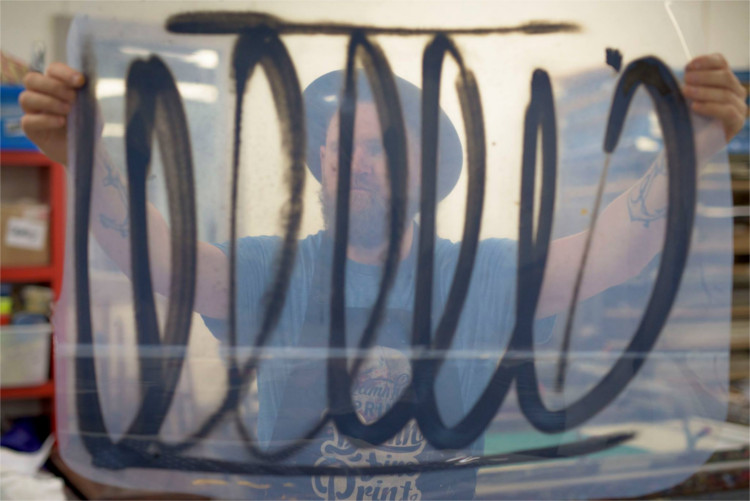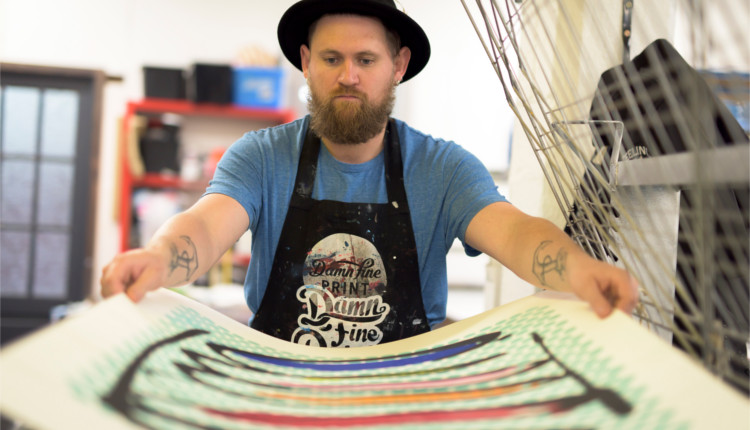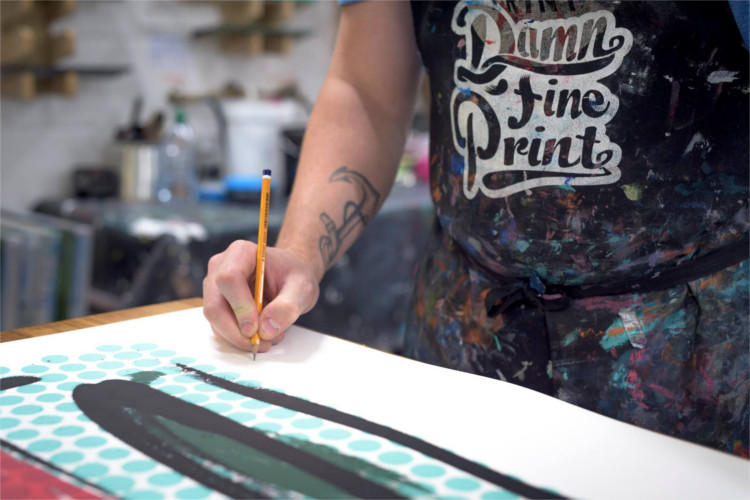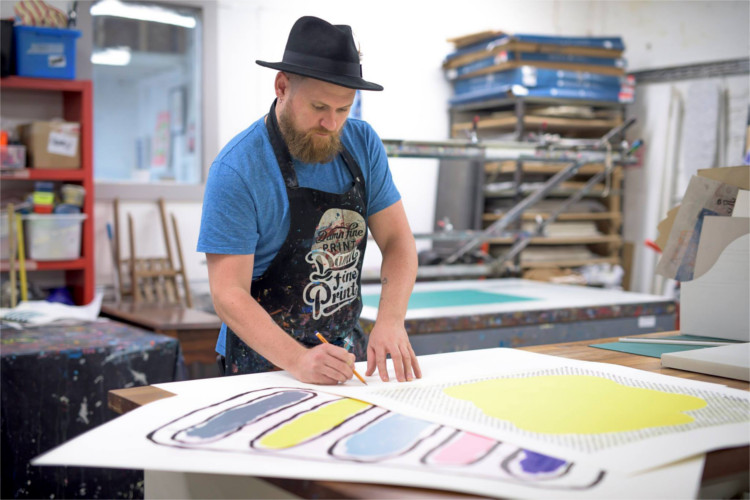‘Elvis Knows’ – A Journey From Paint to Print with Eóin Francis McCormack
Ahead of ‘Elvis Knows’ (Thursday August 17th) – a visual journey from paint to print by critically-acclaimed painter Eóin Francis McCormack I met up with Eóin in his studio to chat about his transition from painting into the world of printmaking, bringing his signatures into another medium, elitism in the arts and collaboration with Damn Fine Print and F R A M E.
‘Elvis Knows’, your upcoming exhibition, looks at the journey taken by you from Painting into Printmaking following a residency with Damn Fine Print. What is your experience with screen printing up to now?
My experience with screen-printing has been very limited and I highly relied on the expertise of Damn Fine Print’s master Printer Liam Gough who assisted me for the entirety of my residency. And of course Kim who runs DFP was amazing. I had an idea of what I wanted to make, but they very much helped me on my journey from painting to print.

The differences between the usual process of your painting and the processes used in printing, for this exhibition, are quite obvious. Was it important to you to keep a sense of familiarity by utilising your signatures in the prints; borders, dots and vibrant bold colours?
Yeah, for sure. Kim asked me do bring my practice into their studio so that’s what I did. It was important for me to make a print that printmakers would appreciate and accept, but it was massively important for me that the pieces would still look like my work. I brought in lots of “painterly” stokes of colour to reference my painting practice and my signature dots and borders play a big role too. Although the process is different, once you know the rules you can manipulate them to suit your own style and make it your own.
Your use of dots are most definitely a signature of your work, where did this facet of the Eoin Francis McCormack style come from?
Yes dots have been part of my work for many years now. I’m constantly on the lookout for interesting dots and ways of making them. I have two types of dots in this series of prints; one is hand draw – to emphasis the labour intensive nature of the print process, the other was a floor mat I saw lying around the studio in DFP. It was a rubber mat with perfect holes in it which I sprayed through onto acetate making my master which was then exposed onto a screen. I love finding things like that and bringing them into the work. Lots of dots on a page can really play with your eyes – stare at them long enough and you start seeing shit!

As mentioned before, another signature of your work are the bold colours; vibrant pinks and yellows, deep reds and rich blues. You have decided to hold onto this palate in the move from paint into print – was that a conscious decision as part of your signature?
Keeping this signature was important. Ultimately what I want to achieve is some kind of uniqueness, I want it to be instantly recognisable as mine. I have always worked with this relatively limited palate. I see the dots, lines, shapes and colours as my arsenal with which I can reference and put my hand to whenever needed.
In your painting there has always been a kinetic component. Sometimes with the sheer volume of paint on the canvas certain colours look to still be moving down the frame, trying to burst from the outer layers of paint. In other pieces there are distinct sweeping brushstrokes arcing across the canvas, drawing the viewer’s eye from one side to the other. Can you tell me about the importance of this aspect in your work?
My work has taken on the sculptural element. In the studio I pour massive amounts of paint onto canvases flat on the floor and then wrestle with these huge canvas in a small studio to create this shapes in my head [I am still pretty unsure how he physically manages this in his tight studio space in Steambox Studios]. This kinetic element really excites me. It’s physical, messy, sexual, and it also takes the artist hand or bush out of the painting which I enjoy. On the other hand, I love to use brushstrokes and again strive for a unique or original mark. With these left to right brushstrokes I feel the viewer “reads” the paintings like a book.
When working in print you are working with a flat image on a sheet of paper. This is nearly the polar opposite of your paintings. Big, bold, tactile. How do you manage to keep that sense of physicality when moving into the printing process?
Good question. This was very important to me to keep that tactile nature I have in my painting. I emphasised the brushstrokes in the prints which straight away gave the prints a wonderful depth. I used spay cans, different brushes, the black borders, the dots, this massive yellow blob I’ve become known for – I pulled out the whole arsenal!
It was certainly a concern when I was confronted with a black white page and a screen, I did wonder how I could bring my flavour to print. Lots of experimentation. I suppose it’s the amount of movement around the page and the fast gestures that keep it in the realm of the physical.

In one of your previous exhibitions ‘WORK’ you talked about the importance to see art as a trade. You talked of the hard graft that goes into your everyday life as a painter. How did you find working in Damn Fine Print, observing other skilled craftspeople in their daily routines and did it make you change anything in moving forward with your own work ethic or process?
Everyone in Damn Fine Print has an amazing work ethic which you can feed off. It’s a proper skilled trade which is a great environment to be part of. As a painter who works alone in the studio all day it was great to bounce ideas about, especially when the people are experts in their field, and everything I learned will be brought back into my own painting practice. I think both can feed off each other.
The title of your show is ‘Elvis Knows’. Having previously named pieces of your work after Bob Dylan songs, why Elvis and why the musical connection to your work?
‘Elvis Knows’ is kind of taken from The Commitments where the father is obsessed with Elvis and he has the picture of Elvis above the Pope in the house. In this case I’m having a bit of fun with the title. Elvis Knows instead of God Knows. Ya know? Me and my brother are always on the look out for Elvis references in anything.
I love naming paintings be it after Dylan songs or how I used to call my Line paintings L1, L2 ,L3 etc just as a means of naming them. This fucking stupid idea of calling something “untitled” is so pretentious to me. I mean even if you’re just to call it ‘Boy with Apple’, that’s grand! I’m not saying it needs to reference the work or tell the viewer anything about the work but I feel because of the long tradition of naming art we should use it.
Another aspect of elitism in the arts seems to stem from the cost of owning art. Pricing is such an integral part of any artist’s life, how do you measure the worth of something you have created?
Yes the art world is elitist in parts and it can seem quite old fashioned in Ireland, with very few proper ballsy galleries, very little risk taken – most are still sticking with safe work. Saying that, I think the industry is in flux. I sell 99% of my paintings myself, though meeting people, approaching people or email. It’s a real funny one at the moment, people are only getting a few bob back in there pocket again after the shit-storm of a crisis we had.
As for pricing work it’s a learning curve. I’ve sold some work far too cheep and others I went in too high – it’s a balance that’s hard to get right but I feel I’ve hit my range now in the last year or so. It’s important not to be too precious about the work too and know your limitations.

Pricing and costs of screen-printing has surely been a huge factor in its popularity. I personally own several prints from artists I love and want to support and it is the lower cost that makes it more accessible for myself and to the masses. Was this a factor in choosing to take on this project?
As well as Damn Fine Print, where you completed the residency ahead of this show, you have the South William Street pop-up F R A M E involved for this exhibition, framing your pieces on the night and housing the exhibition. Can you tell me a little about the partnership and your collaboration?
So Trevor from F R A M E kindly asked Damn Fine Print and myself to put on ‘Elvis Knows’ in his pop up on South William street. It promises to be a wonderful evening we have a beer sponsor sorted which as you know is the main thing for loosening people purse strings haha. So yea Trevor from F R A M E does these mental cool frames which I can’t wait to see the finished pieces. He is making frames for the event that will have elements of the prints in it; like the dots or picking up on colours of the paint or curved mounts. A total artist in his own right.
Get down to F R A M E on William Street South this Thursday from 6pm for some drinks and some fantastic prints from on of the finest contemporary artists in Dublin. Follow Eóin on Twitter, Instagram and Facebook.
More information on the exhibition can be found on the Facebook event page.
